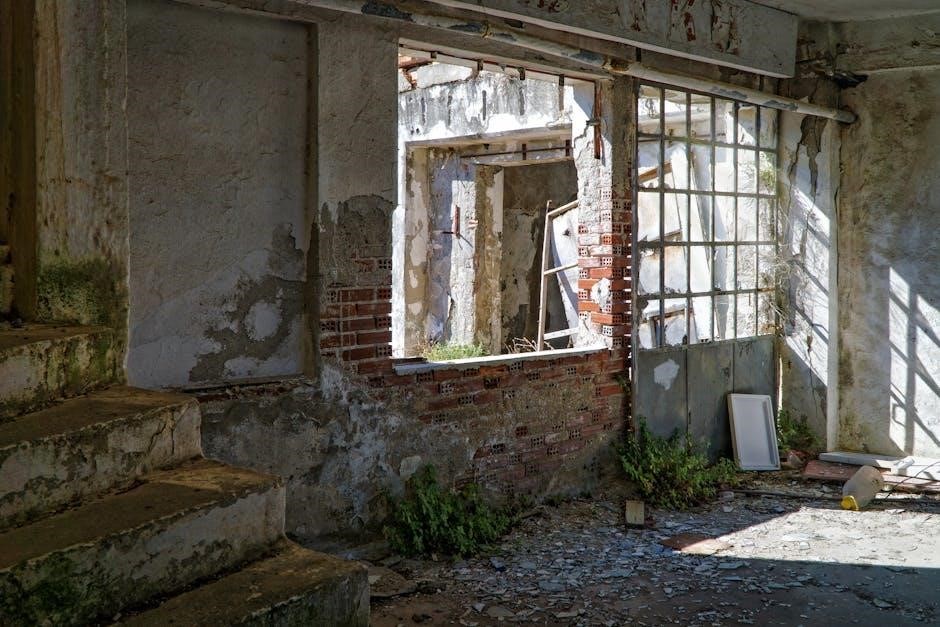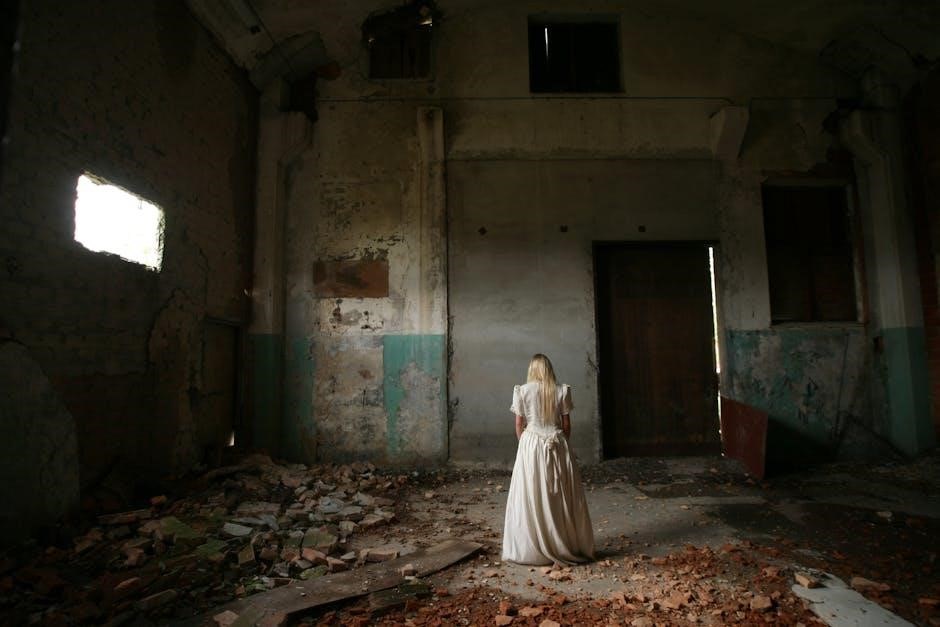Vecna: Eve of Ruin is a high-level Dungeons & Dragons adventure spanning levels 10-20, designed to stop Vecna’s catastrophic plan to reshape the multiverse in his image.
Overview of Vecna: Eve of Ruin
Vecna: Eve of Ruin is a high-stakes, level 10-20 Dungeons & Dragons adventure that pits players against the legendary lich Vecna, who seeks to reshape the multiverse in his evil image. This epic campaign begins with a prelude adventure, Nest of the Eldritch Eye, introducing players to Vecna’s influence and the cultists who serve him. The main adventure spans the multiverse, featuring planar travel, iconic locations like Sigil and Ravenloft, and the quest to assemble the Rod of Seven Parts, a powerful artifact crucial to stopping Vecna. With a focus on high-level combat, unique artifacts, and a secrets subsystem, this adventure offers a rich, dynamic experience. Players must navigate Vecna’s growing power and confront him in a climactic battle to determine the fate of the multiverse.
Key Features of the Adventure
Vecna: Eve of Ruin offers a multitude of engaging features designed to enhance gameplay and immersion. The adventure introduces a unique Secrets Subsystem, allowing players to leverage uncovered secrets for strategic advantages in combat and exploration. High-level combat encounters are a hallmark, providing challenging battles against formidable foes. Players can acquire powerful artifacts, including the Rod of Seven Parts, which plays a central role in the narrative. The campaign emphasizes player agency, with meaningful choices that impact the story and its outcomes. Additionally, the adventure spans multiple planes and worlds, such as Eberron, Ravenloft, and the Nine Hells, offering diverse settings for exploration. These elements combine to create a dynamic and epic experience tailored for high-level play.

Background
Vecna: Eve of Ruin delves into Vecna’s lore as a legendary villain in Dungeons & Dragons, exploring his return and the multiversal chaos he unleashes, guided by the Wizards Three.
The Lore of Vecna in Dungeons & Dragons
Vecna, a legendary lich, has long been a cornerstone of Dungeons & Dragons lore, embodying unparalleled power and ambition. His rise from a sorcerer to a god underscores his relentless pursuit of domination. In Vecna: Eve of Ruin, his return threatens the multiverse, as he seeks to reshape reality in his image; The Wizards Three—Mordenkainen, Tasha, and Alustriel—play pivotal roles in countering his plans. Vecna’s lore is deeply intertwined with the Rod of Seven Parts, a powerful artifact central to stopping his ascension. The adventure’s prelude, Nest of the Eldritch Eye, introduces players to Vecna’s cultists, setting the stage for the epic confrontation. His legacy as a master of secrets and manipulation makes him a formidable antagonist.
Setting and Timeline of the Adventure
Vecna: Eve of Ruin unfolds across the multiverse, with the prelude adventure, Nest of the Eldritch Eye, introducing players to Vecna’s influence in Neverwinter at level 3. The main adventure spans levels 10-20, taking players through diverse planes such as Eberron, Ravenloft, and the Nine Hells. Set in the Forgotten Realms during 1491 DR, the story follows the aftermath of Shadow of the Dragon Queen, positioning Vecna’s return as a catastrophic event. Players explore iconic locations like Sigil and Undersigil, engaging in a race against time to collect the Rod of Seven Parts. The adventure concludes with a climactic battle to determine the fate of the multiverse, offering a high-stakes narrative that blends horror, mystery, and epic scope.

Adventure Structure
Vecna: Eve of Ruin includes a prelude, Nest of the Eldritch Eye, for 3rd-level characters, followed by a main adventure spanning levels 10-20, a quest for the Rod of Seven Parts, and a climactic battle against Vecna.
Vecna: Nest of the Eldritch Eye (Prelude Adventure)
Vecna: Nest of the Eldritch Eye is a one-shot prelude adventure designed for 3rd-level characters, serving as an introduction to the larger Vecna: Eve of Ruin campaign. This adventure sets the stage by introducing players to Vecna’s cultists, known as the Whispered Ones, and their sinister activities in Neverwinter. The story begins with the party investigating strange occurrences, leading them to uncover a cult plot tied to Vecna’s growing influence. This prelude provides essential background on Vecna’s lore and the impending threat he poses, while also establishing key locations and NPCs that will feature prominently in the main adventure. It serves as a crucial primer, preparing players for the epic multiverse-spanning journey ahead.
Main Adventure: Levels 10-20
The main adventure in Vecna: Eve of Ruin is a high-stakes, multiverse-spanning campaign designed for characters from level 10 to 20; Players must race against time to prevent Vecna’s catastrophic plan to reshape reality. The adventure is structured around retrieving the fragments of the Rod of Seven Parts, a powerful artifact capable of defeating Vecna. Along the way, characters will explore diverse planes and worlds, engaging in epic combat encounters and unraveling the mysteries of Vecna’s return. The Wizards Three—Mordenkainen, Tasha, and Alustriel—play a pivotal role in guiding the party, while the Secrets Subsystem adds depth by allowing players to leverage hidden knowledge for strategic advantages. This high-level adventure demands skill, creativity, and sacrifice to save the multiverse from Vecna’s evil grasp.
The Quest for the Rod of Seven Parts
The Quest for the Rod of Seven Parts is central to Vecna: Eve of Ruin, as it is the only artifact capable of defeating Vecna. The adventure sends players across the multiverse to retrieve the rod’s scattered fragments. Each part is hidden in a different plane or world, requiring the party to navigate diverse environments and challenges. The rod’s power grows as each piece is collected, granting the party unique abilities and insights into Vecna’s plans. The quest is not just about retrieving fragments but also understanding the rod’s history and significance. This journey tests the party’s resolve, strategy, and ability to work together, as Vecna’s forces actively seek to prevent their success. Successfully assembling the rod is crucial for the final confrontation, making this quest both a race against time and a defining moment in the adventure.
Climactic Battle Against Vecna
The final confrontation with Vecna is a monumental, high-stakes battle that concludes the adventure. Players must use the fully assembled Rod of Seven Parts to weaken Vecna, as it is the only force capable of countering his divine power. The battle takes place across multiple planes, with Vecna unleashing devastating abilities that test the party’s strength, strategy, and creativity. The encounter is designed to challenge even the most experienced players, with intricate mechanics and opportunities for heroism. The outcome determines the fate of the multiverse, making every decision and action critical. This climactic showdown is a fitting end to the adventure, offering a mix of epic scope and personal stakes.

Plot and Storyline
Vecna’s return threatens the multiverse, prompting the Wizards Three to unite heroes across planes. The quest for the Rod of Seven Parts is central to stopping Vecna’s evil plan, ensuring a climactic showdown.
The Threat of Vecna’s Return
Vecna’s return poses an existential threat to the multiverse, as he seeks to reshape reality in his image, erasing entire planes and civilizations. The Wizards Three—Mordenkainen, Tasha, and Alustriel—unite to thwart his ambitions, recognizing the catastrophic consequences of his triumph. Vecna’s power is unmatched, and his resurgence could plunge the cosmos into eternal darkness and chaos, enslaving countless souls. The adventure underscores the urgency of stopping him, as his plan progresses relentlessly, threatening to unravel the fabric of existence itself.
The Role of the Wizards Three
Mordenkainen, Tasha, and Alustriel, known as the Wizards Three, play pivotal roles in Vecna: Eve of Ruin. They serve as the primary architects of the resistance against Vecna, employing their vast magical prowess and strategic brilliance to counter his schemes. The Wizards Three guide the players, providing crucial missions and insights, while their own motivations and histories add depth to the narrative. Their actions are driven by a desperate need to preserve balance in the multiverse, making them both allies and mentors to the adventurers. Their presence underscores the epic stakes, as these legendary figures rally forces to prevent Vecna’s domination.
Exploring Multiple Planes and Worlds
Vecna: Eve of Ruin offers a vast multiversal adventure, allowing players to traverse diverse planes and worlds, each rich in lore and unique challenges. From the shadowy jungles of Ravenloft to the futuristic landscapes of Eberron, the adventure seamlessly integrates iconic D&D settings. The Nine Hells, with its infernal bureaucracy, and the chaotic expanse of the Far Realm further expand the scope. Each plane introduces distinct enemies, allies, and storylines, creating an immersive experience. Players uncover fragments of the Rod of Seven Parts across these realms, weaving together a narrative that spans dimensions. This design encourages exploration and highlights the epic scale of Vecna’s threat, offering a taste of D&D’s expansive multiverse.
The Final Confrontation and Its Consequences
The climax of Vecna: Eve of Ruin pits players against the lich lord in an apocalyptic showdown. Vecna’s ascension threatens cosmic balance, requiring players to make sacrifices and strategic decisions. The battle is both cinematic and mechanically intense, with Vecna’s divine powers pushing high-level parties to their limits. Defeating him demands mastery of the Secrets subsystem and clever use of the Rod of Seven Parts. The aftermath reshapes the multiverse, with consequences tied to player choices. Success prevents Vecna’s domination but leaves lasting scars, while failure plunges reality into chaos. This conclusion offers a satisfying end to the epic journey, with lasting impacts on the campaign world and its lore.

Game Mechanics and Features
Vecna: Eve of Ruin introduces innovative mechanics like the Secrets subsystem, enhancing gameplay with strategic depth. High-level combat challenges players, while planar travel and unique artifacts offer rich exploration opportunities, making this adventure a standout experience for both players and DMs.
The Secrets Subsystem: Mechanics and Impact
The Secrets subsystem in Vecna: Eve of Ruin adds a layer of strategy and storytelling, allowing players to uncover and wield critical information. Players can gather secrets through exploration, interactions, or defeating enemies, which can then be used to gain advantages in combat, solve puzzles, or influence the narrative. This subsystem incentivizes creative problem-solving and adds depth to encounters, making players feel like their discoveries truly matter. The mechanics are designed to be flexible, enabling DMs to adapt secrets to the party’s actions and decisions. By integrating secrets into the adventure, the system enhances player agency and immersion, making the fight against Vecna feel personal and high-stakes. This innovative feature elevates the adventure’s replayability and engagement.
High-Level Combat Encounters and Strategies
Vecna: Eve of Ruin features epic, high-level combat encounters designed for experienced players. These battles are strategically crafted to challenge even the most powerful parties, with complex enemy tactics and unique mechanics. The adventure includes iconic foes like Vecna’s minions, planar entities, and other high-stakes adversaries. To succeed, players must utilize advanced strategies, such as coordinated teamwork, optimal use of spells and abilities, and clever exploitation of enemy weaknesses. DMs are provided with detailed stat blocks and encounter designs, ensuring balanced yet thrilling fights. The climactic showdown with Vecna himself is a multi-phase battle requiring creativity and sacrifice. These encounters emphasize the importance of preparation, adaptability, and collaboration, making combat a true test of skill and ingenuity.
Unique Artifacts and Magic Items
Vecna: Eve of Ruin introduces a variety of unique artifacts and magic items that play a crucial role in the adventure. The Rod of Seven Parts is central to the story, granting immense power to those who possess it. Other artifacts, such as Vecna’s own relics, hold significant lore and abilities that shape the campaign. Additionally, the adventure includes new and returning magic items from D&D’s rich history, including planar entities and items tied to specific settings like Eberron and Ravenloft. These items are not only powerful but also deeply integrated into the narrative, offering players meaningful choices and strategic advantages. The adventure balances these items to ensure they enhance gameplay without overshadowing other elements, making them a memorable part of the journey to stop Vecna’s evil plans.
Character agency and meaningful choices
Vecna: Eve of Ruin emphasizes player agency, allowing characters to make impactful decisions that shape the story and its outcomes. The adventure encourages players to explore their alignments, approaches, and goals, ensuring their choices resonate throughout the multiverse. Whether forging alliances, uncovering secrets, or wielding powerful artifacts like the Rod of Seven Parts, players’ decisions carry significant weight. The campaign’s design promotes engagement, enabling players to influence key events and confront Vecna in ways that reflect their unique identities. This focus on meaningful choices enhances the narrative depth, making each playthrough a personalized journey through the epic struggle to stop Vecna’s ruinous ambitions.

Settings and Locations
Vecna: Eve of Ruin features diverse settings like Sigil, Eberron, and Ravenloft, with planar travel enabling exploration of the multiverse’s depths.
Exploring the Multiverse: Key Planes and Worlds
Vecna: Eve of Ruin takes players across the multiverse, visiting iconic planes and worlds like Eberron, Dragonlance, and Ravenloft. These settings offer unique environments and encounters, from the high-tech wonders of Eberron to the gothic horror of Ravenloft. Players will also delve into the chaotic streets of Sigil and the depths of the Nine Hells, encountering a variety of creatures and challenges. The adventure seamlessly blends these diverse locations, providing a rich tapestry of experiences that highlight the breadth of D&D’s multiverse. Each plane and world introduces new lore, NPCs, and plot hooks, enriching the narrative and offering endless opportunities for exploration and discovery.
Significant Locations: Sigil, Eberron, and Ravenloft
Sigil, the City of Doors, serves as a central hub for planar travel, offering players a chance to interact with diverse factions and uncover hidden secrets. Eberron introduces a blend of magic and technology, with its unique artificer culture and intrigue-ridden cities. Ravenloft, meanwhile, immerses players in gothic horror, complete with haunted castles and terrifying creatures. Each location provides distinct encounters, NPCs, and story hooks, allowing players to experience the rich diversity of D&D’s multiverse. These settings are integral to the adventure, offering opportunities for exploration, combat, and role-playing that deepen the narrative and enhance the epic scope of the campaign against Vecna.
Planar Travel and Navigation
Planar travel in Vecna: Eve of Ruin is a key mechanic, allowing players to traverse diverse worlds and planes. The adventure provides detailed rules for navigating the multiverse, including the use of magical portals, spelljammer ships, and ancient artifacts. Players must master these methods to track down Vecna’s forces across different realities. The system emphasizes strategic planning and resource management, as each plane presents unique challenges and opportunities. From the chaotic streets of Sigil to the mysterious demiplanes, the journey requires adaptability and creativity. This mechanic enriches the story, enabling players to explore iconic D&D settings while maintaining a cohesive narrative drive toward the final confrontation with Vecna.
The Role of the Nine Hells
The Nine Hells play a pivotal role in Vecna: Eve of Ruin, serving as a central location for the adventure’s high-stakes battles and political intrigue. As Vecna seeks to expand his influence, the Hells become a battleground where players must navigate the complex web of alliances and rivalries among archdevils. The adventure provides detailed descriptions of key locations within the Hells, such as the fortress of Dis and the scheming courts of Baator. Encounters with iconic fiends like Mephistopheles and Asmodeus add depth to the narrative, while the infernal armies pose formidable challenges. The Nine Hells’ rich lore and strategic importance make them a cornerstone of the adventure, tying Vecna’s ambitions to the broader D&D multiverse.

Themes and Tone
Vecna: Eve of Ruin explores themes of power, sacrifice, and legacy, blending a dark, ominous tone with elements of cosmic horror and mystery, creating an epic yet unsettling narrative.
Themes of Power, Sacrifice, and Legacy
Vecna: Eve of Ruin delves into profound themes of power, sacrifice, and legacy, as the adventure revolves around Vecna’s quest for godlike dominion over the multiverse.
The narrative explores the corrupting influence of power and the moral dilemmas faced by heroes who must confront an existential threat. Sacrifice emerges as a central motif, with characters forced to make difficult choices to prevent Vecna’s triumph.
Legacy is also a key theme, as the campaign highlights the lasting impact of the players’ actions on the multiverse. The adventure’s epic scope and high stakes create a sense of urgency, underscoring the importance of their decisions.
Tone and Atmosphere: Horror, Mystery, and Epic Scope

Vecna: Eve of Ruin masterfully blends horror, mystery, and epic scope to create a gripping narrative. The looming threat of Vecna’s return evokes a sense of dread, while the cryptic nature of his plans keeps players engaged in unraveling the mystery. The adventure’s tone shifts seamlessly from eerie encounters with cultists to grand, multiverse-spanning battles, maintaining an epic feel throughout. High-stakes encounters and the potential for catastrophic consequences amplify the tension, immersing players in a world teetering on the brink of destruction. This balance of dark themes and expansive storytelling ensures a memorable experience, making Vecna: Eve of Ruin a standout adventure in Dungeons & Dragons.

Guide for Dungeon Masters
Vecna: Eve of Ruin offers detailed tools for DMs, including tips for managing high-level play, balancing encounters, and integrating the Secrets subsystem to enhance player engagement and immersion.
Preparing for Vecna: Eve of Ruin
Preparing for Vecna: Eve of Ruin requires meticulous planning due to its epic scope and high-level gameplay. Dungeon Masters should thoroughly familiarize themselves with Vecna’s lore and the multiverse’s intricate settings. Understanding the Secrets Subsystem is crucial, as it significantly impacts combat dynamics and narrative flow. DMs must also balance encounters for levels 10-20, ensuring challenges are both formidable and fair. Utilizing the prelude adventure, Nest of the Eldritch Eye, helps introduce players to Vecna’s influence and the overarching plot. Additionally, organizing player agency and meaningful choices in advance enhances immersion and engagement throughout the campaign, making the adventure memorable and impactful for all involved.

Managing the Secrets Subsystem
Managing the Secrets Subsystem in Vecna: Eve of Ruin is vital for maintaining player engagement and enhancing the adventure’s mystery. This mechanic allows players to uncover and utilize secrets to gain strategic advantages in combat and narrative. DMs must carefully balance the incentives for discovering secrets, ensuring they are rewarding but not overpowered. Tracking secrets across sessions can be complex, so creating a dedicated system or using a Secrets Tracker is recommended. Additionally, integrating secrets into the story naturally, such as through environmental clues or NPC interactions, enhances immersion. Encourage players to use secrets creatively while maintaining the subsystem’s integrity to keep the game dynamic and suspenseful throughout the campaign.
Balancing High-Level Encounters
Balancing high-level encounters in Vecna: Eve of Ruin requires careful consideration of player strength, strategy, and narrative impact. The adventure features complex, high-stakes battles designed for levels 10-20, making it essential to tailor encounters to the party’s abilities. DMs should leverage the unique stat blocks and strategies provided, ensuring each fight feels epic and challenging without overwhelming the players. Incorporating player agency and meaningful choices adds depth, allowing the party to influence outcomes. Balancing these elements ensures a dynamic and engaging experience, keeping the game exciting and rewarding for high-level play.
Encouraging Player Agency and Engagement
Encouraging player agency is crucial in Vecna: Eve of Ruin, as it fosters immersion and investment in the story. The adventure offers meaningful choices that impact the narrative, allowing players to shape outcomes and determine the fate of the multiverse. By providing opportunities for alignment shifts, strategic decisions, and role-playing interactions, DMs can deepen engagement. Players’ decisions influence Vecna’s power and the final confrontation, making their actions feel consequential. This emphasis on agency ensures that each party’s journey is unique, enhancing the overall epic experience and rewarding creative problem-solving and collaboration.
Vecna: Eve of Ruin offers an epic, high-level adventure with profound stakes, challenging combat, and rich storytelling, making it a memorable experience for both DMs and players alike.
Final Thoughts and Recommendations
Vecna: Eve of Ruin stands out as a pinnacle of high-level D&D adventures, offering a rich narrative, strategic combat, and multiverse-spanning exploration. DMs are encouraged to embrace the Secrets subsystem and player agency to enhance immersion. While the adventure is robust, supplements like DAlva’s Guide can add depth. For new DMs, starting with the prelude Nest of the Eldritch Eye is recommended to acclimate players. Experienced DMs should focus on balancing encounters and fostering meaningful choices. The adventure’s themes of power and sacrifice resonate deeply, making it a must-play for fans of epic storytelling and high-stakes gameplay in D&D 5E.